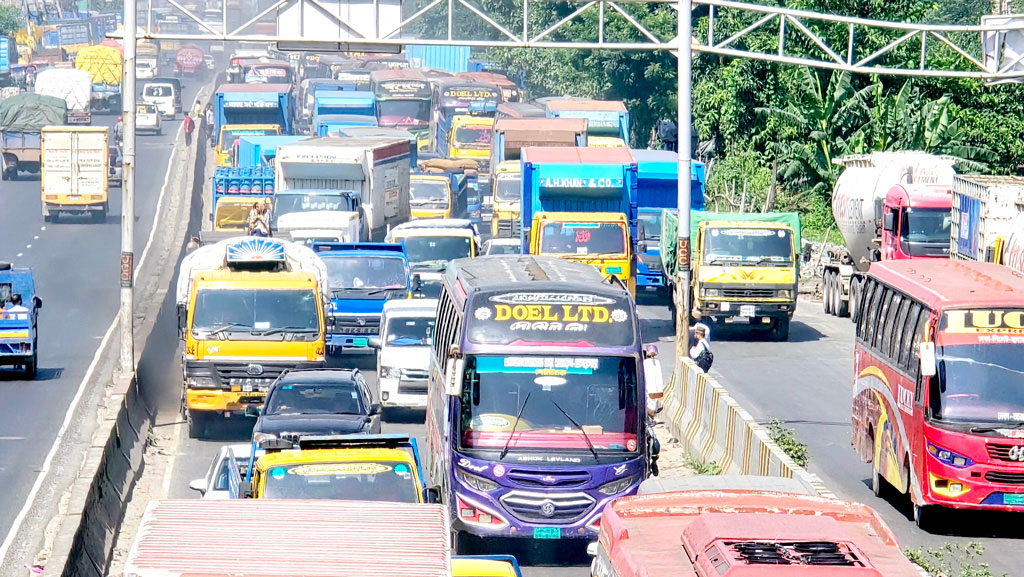Desk Reports :
Road accidents are increasing in the country. Along with fast-moving vehicles, slow-moving vehicles are one of the main causes of accidents. Experts say that the risk of accidents on highways is increasing due to the lack of adequate service lanes. The highways that have service lanes merge into highways at some distance. Drivers do not know the rules for using service lanes. There is also not enough publicity about the penalties for violating the rules. The concerned authorities consider construction to be the only solution.
Professor Dr. Mohammad Mahbub Alam Talukder of the Accident Research Institute (ARI) of Bangladesh University of Engineering and Technology (BUET) told Ajker Patrika that there are not enough service lanes in Bangladesh. Even on the ones that do exist, vehicles plying on the main roads increase the risk. The level of risk increases due to exceptions to the rules. The purpose for which service lanes are built in the country is not implemented.
The busiest is the Dhaka-Chittagong Highway. This highway, which is the first four-lane highway in the country, does not have a service lane. As a result, slow vehicles, including CNG-powered autorickshaws, battery-powered autorickshaws, rickshaw vans and other vehicles, are also moving on this highway in parallel with heavy and fast vehicles.
As a result, accidents often occur on this highway due to slow vehicles. Accidents are causing loss of life. Severe traffic jams are being created. Experts say that if there were service lanes, the accident rate on this important highway would have been reduced to a large extent.
On August 23, around 9:30 am, battery and CNG-powered autorickshaws were seen moving in the opposite direction in the Comilla section of the Dhaka-Chittagong highway during torrential rain. No action was taken by the police to stop this movement in the opposite direction. However, the previous day, a covered van overturned on a private car and a CNG-powered autorickshaw that were taking a U-turn in Padua Bazar, Comilla. Four people from the same family in the car were killed.
An official of the Highway Police, who did not wish to be named, said that it was a big mistake not to have a service lane on the Dhaka-Chittagong Highway. There are 662 feeder roads on this highway. If there were service lanes, vehicles would not have been able to enter the highway directly from the feeder road; or they would not have had the opportunity to travel in the opposite direction. For example, there are service lanes on the Dhaka-Bhanga Expressway.
There are service lanes throughout the Dhaka-Bhanga Expressway. As a result, slow-moving vehicles do not enter the highway much. But there are no service lanes throughout the SASEC-1 (Gazipur-Elenga) Highway. Service lanes merge with the highway at some points. A 48-kilometer stretch of the Dhaka Bypass Four-Lane Expressway is being constructed from Bhogra in Gazipur with service lanes. Of this, 18 kilometers from Bhogra to Bhulta have been opened for traffic. Service lanes are being built in the four-lane project of SASEC-2 (Elenga-Rangpur), Dhaka-Sylhet Highway, Sylhet-Tamabil Highway, Ashuganj River Port-Sarail-Dharkhar-Akhaura Land Port Highway. Although there is a service lane on one side of the Hatikumrul-Banpara Highway, it merges with the main road after some distance.
Saidur Rahman, Executive Director of the Road Safety Foundation, said, “The main feature of the highway should be service lanes. This is mandatory. Although we have service lanes on several highways, they merge with the main road after some distance. Road dividers must be installed on highways where there are no service lanes; but that is not being done either.”
Public sources said that a plan has been taken to make the Dhaka-Chittagong Highway an expressway on the model of the Dhaka-Bhanga Expressway. A design has also been prepared for this. It may cost more than 60 thousand crore taka to build. In the meantime, assistance from development partners has been sought.
BUET Professor Mohammad Mahbub Alam Talukder said, “The responsibility here is considered to be the end of the infrastructure. But there is no thought about making users aware. In developing countries, along with infrastructure development, users’ knowledge and awareness need to be increased. Drivers need to be made aware, they need to be informed about the rules and risks of the road.
Sources from the Department of Roads and Highways (DOH) said that in some areas, service lanes were required to be 20 feet. But due to lack of space, they had to be made 16-18 feet. These will have to be adjusted in the future.
Several DOH engineers, who did not want to be named, said that having service lanes on highways would reduce accidents. But due to financial constraints, service lanes cannot be built on all highways. There are also instructions not to destroy agricultural land. The practice of service lanes in the country is not very old. The government plans to include service lanes during the construction of important highways in the future.
When asked, Additional IG of Highway Police Md. Delwar Hossain Miah said that it is difficult to control slow-moving vehicles on highways without service lanes. There are fewer CNG auto-rickshaws and battery-powered auto-rickshaws on highways with service lanes, and the accident rate is also low. He requested that the highways that will be expanded from now on must include service lanes.
Additional Chief Engineer (Planning and Maintenance) of the Highways Department Md. Moniruzzaman believes that service lanes are necessary to reduce speed and travel time on highways. He said that service lanes are necessary to make highways safer. At the same time, slow-moving vehicles are also needed for the movement of local people. Due to budget constraints, it has not been possible to have service lanes on all highways. He said that there is not enough land in the country. Agricultural land is destroyed. There are markets next to the highways. When you want to expand the highway, you have to remove them. These are their limitations.




